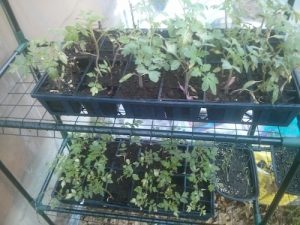It is my pleasure to introduce you to Don Abbott, the Snarky Gardener. Professionally he’s a software developer but spends his spare time producing food at Snarky Acres, his rented 0.91 acre urban farm. Living in Ohio, Don is a gardener, blogger, author, educator, speaker, reluctant activist, and permaculture practitioner.
Don has graciously shared his best tips and tricks for us on how to start seeds (outdoors or in doors, for us Canadians). Our traditional last frost date for planting in Canada is May 24, so now is the time for us to start those indoor seeds!
Growing your own garden starts takes some trial and error. Here are some lists to help you out.
Supplies you need.
- Seed starting mix (soilless soil)
- Trays / pots
- Watering cans / spray bottles
- Seeds (no kidding)
- Artificial lights or a south facing window
- Heat mat (optional)
- Fan (optional)
- Small greenhouse (optional)
- Patience (not optional)
Potential issues.
Leggy plants – this is a problem I’ve seen over and over again. In order to have healthy starts, they must have a good lighting source. If your plants get really tall without much greenery, put the lights closer (maybe a few inches away) but not so close they get burnt.
Hardening-off – starts need to have some time to acclimate to the outside world. Start by putting them out a few hours a day (preferably in the shade at first). A small greenhouse would be helpful if you have a bunch of starts. Doing the hardening hokey-pokey (put your starts out, bring your starts in …) gets real old real fast.
Watering – don’t water too much. Seeds and starts don’t like being wet. They will mold and “dampen off” easily. Plus if you water a lot, you will be training your plants to be needy when they are adults.
Poor germination – Different seeds germinate at different temperatures. Peppers and eggplants, for example, need 80 degrees fahrenheit or higher to “pop”. This is where you might want to use a heat mat under your seeds.
Germination time – different seeds need different amount of days to sprout. Brassicas (cabbage, turnips, mustard, arugula, etc) will come up in 3 days or less while carrots, parsley, and dill might take up to 21 days. Make sure to check your seed package for your specific number of days.
When to start – this will be usually on the seed packet. You will need to know your last average frost date ( http://www.planthardiness.gc.ca/ or http://planthardiness.ars.usda.gov/PHZMWeb/ ) and then count backwards. For tomatoes and peppers, it’s 6 to 8 weeks before your last average frost date.
When to plant – this is determined by your last average frost date plus keeping an eye on your weather. Many a gardener has been cursed by a later than normal frost. Watch your weather reports for a frost or freeze warning. You may need to bring plants inside or cover them with cloth or other material (but not plastic).
Remember: your starts are basically baby plants. They will need your constant care until they are planted (and then a little more after that). – Don AbbotT

Vegetables to only start inside.
- Tomatoes
- Peppers
- Eggplants
- Ground cherries
Vegetables you can start inside or direct seed outside (gardener’s choice).
- Squash
- Cucumbers
- Pumpkins
- Swiss chard
- Spinach
- Lettuce
- Dill
- Parsley
- Lettuce
- Broccoli
- Cabbage
- Kohlrabi
Vegetables to direct seed outside only:
- Corn
- Beans
- Peas
- Turnips
- Carrots
- Beets
- Sunflowers
- Any other root vegetables
Final thoughts.
What vegetables are you planning to grow in your garden this year? Do you have a true-and-tested method or brand of seed that you prefer? Don and I would love to hear about it in the comments.